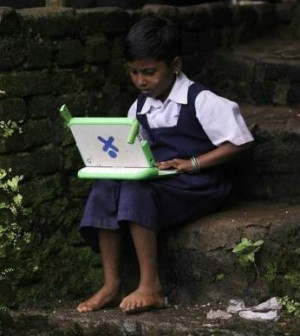- Finding Unshakable Power in a World That Wants to Pull Us ApartPosted 5 months ago
- What could a Donald Trump presidency mean for abortion rights?Posted 5 months ago
- Financial Empowerment: The Game-Changer for Women in Relationships and BeyondPosted 6 months ago
- Mental Health and Wellbeing Tips During and After PregnancyPosted 6 months ago
- Fall Renewal: Step outside your Comfort Zone & Experience Vibrant ChangePosted 6 months ago
- Women Entrepreneurs Need Support SystemsPosted 7 months ago
Strong economies start with girls and women — not robots

Author: Katja Iversen, Women Deliver from trust.org
In this file 2010 photo, a school girl uses a laptop provided under the “One Laptop Per Child’ project in a state-run primary school in Khairat village, about 90 km (56 miles) from Mumbai. REUTERS/Danish Siddiqui
Any views expressed in this article are those of the author and not of Thomson Reuters Foundation.
DAVOS, Switzerland – This year’s World Economic Forum opened with a dire warning for girls and women. According to a new report by the forum’s organizers, women’s employment and economic prospects—which have been improving globally, but still lag behind men’s—risk suffering a major setback in the decades to come.
The culprit? Experts predict that the next industrial revolution, sometimes referred to as the “fourth” or “robot” revolution, will see staple jobs and businesses uprooted by automated technologies. In the new economy, girls and women face a double-edged sword: they will be overrepresented in routine roles at risk for displacement by automation, and underrepresented in the professions that will gain in value—including science, technology, engineering and mathematics (STEM).
This warning does not have to be our fate. It’s a wake-up call of what could happen if we stand back and allow technological trends to shape the future in undesirable ways. Instead, we can proactively design an economy that opens doors for girls and women and, ultimately, drives economic progress and global security for everyone.
While World Economic Forum experts are right to encourage measures to boost women’s participation in STEM education and STEM jobs, a narrow focus on this approach risks overlooking the root of the problem. Women are less likely to work in the most respected fields because of the broader gender gaps that persist in health, education and political and economic rights, particularly in the developing world.
Put differently, girls and women will compete ably in the new economy if they are given the chance to become educated not child brides or teenage mothers.
Fortunately, we are well aware of the investments that set girls and women up for success: Access to essential health services throughout the course of her life, so that she can stay healthy, decide if and when to become pregnant and set goals for her future. Quality and comprehensive education, so that she can discover her passion and master 21st century skills. Laws and rights that provide the foundation for a life free of violence and discrimination.
These and other investments in girls’ and women’s wellbeing are effective, are affordable and produce a huge positive ripple effect. They are investments that society has a collective, vested interest in prioritizing. Because women deliver—much more than babies.
Ensuring bright employment and economic prospects for girls and women benefits everyone. Strong, healthy and educated girls and women are the bedrock of a thriving economy. When there is no limit to what a girl can achieve in her lifetime—no boundaries preventing her from reaching her full potential—communities thrive, economies grow and nations become more resilient. A 2015 report estimated that advancing gender equality would add US$12 trillion to global GDP in one decade. Achieving it would add $37 trillion.
Rather than fearing new technologies, it is important to look for opportunities to harness technology to supplement and accelerate investments in girls’ and women’s health, education and rights. Historically, technology has been man-made and man-owned. For example, despite women constituting the majority of the agricultural work force, men are often the primary designers and adopters of agricultural innovations. Men are also far more likely than women to have access to new communications technologies such as the Internet and mobile phones, which grant privileged access to expanded networks and information.
More innovations designed by women, for women, could be transformative for key sectors like agriculture, energy, communications and transportation. To meet the challenges of the 21st century head on, women’s creative, intellectual and entrepreneurial potential must be fully engaged, and girls and women should benefit equally from groundbreaking technologies.
The “robot” revolution is not the first disruption to the job market, and it will not be the last. A sustainable response is to ensure that whenever the rules of the economy may change, girls and women will be standing on solid and equal footing alongside their male counterparts, instead of racing to catch up. Investments in girls’ and women’s health, rights and wellbeing will pave the way.
It is comforting that world influencers like Bill and Melinda Gates used the platform in Davos to pledge to prioritize girls and women’s health, rights and empowerment, and many others are following suit. At the Women Deliver 2016 Conference in Copenhagen this May, advocates and leaders from around the world will focus on solutions and how to make the new Sustainable Development Goals matter for girls and women. But they don’t have to wait until May for this vital conversation, because Davos is a great place to start it.
The next industrial revolution can be a leap forward for women and for everyone. We can’t afford otherwise.
Katja Iversen is CEO of Women Deliver, a leading global advocate for girls’ and women’s health, rights, and wellbeing. Women Deliver believes that when the world invests in girls and women, everybody wins.






